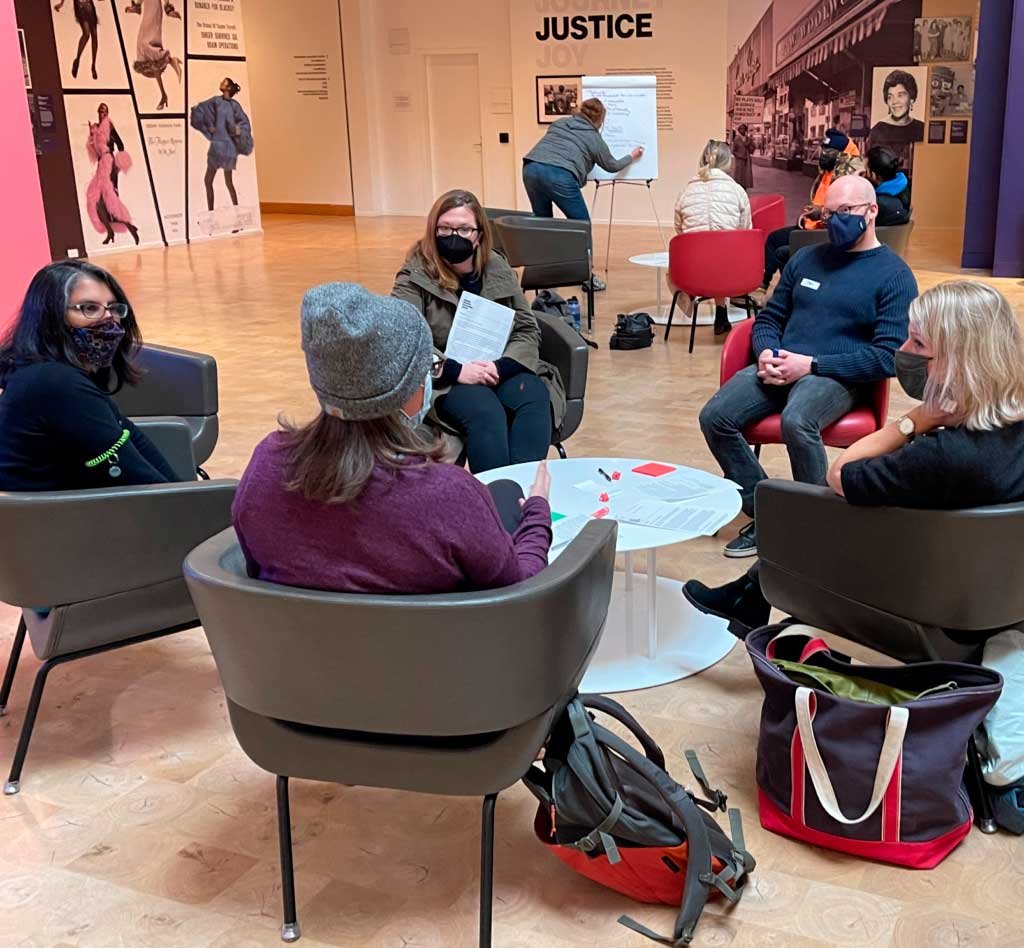Communiqué from Local Assembly Alaska
The Alaska local assembly took place at the Museum of Anchorage on 4th October 2021. Sixteen participants joined, including museum staff, local businesses and designers. Most participants were born in Alaska, and all participants lived in Alaska.
The list of attendees was not industry specific and a range of backgrounds was represented by participants, including a nationally renowned textile artist, an Inupiat fashion designer and 5th generation skin sewer, local designers and re-designers, small scale makers, and retail entrepreneurs.
Board member Lynda Grose introduced the UCRF manifesto and guidelines for participating with active listening. Participants then broke into three groups of 5-6 people to discuss the UCRF manifesto points and to identify which ones resonated the most strongly for them. Museum staff helped capture information and facilitate discussions. The outputs and insights are listed below.
Manifesto point #6: Take a leadership role in debunking existing ideas
Policies today offer too many outs for not making meaningful change.
Sustainability in fashion wasn’t a consideration before western industrial times.
Diversify the voices in fashion and sustainability – note who isn’t invited to bring their perspective?
Amplify and strengthen the relationship between humans and art.
Shift away from the culture of new which isn’t always better.
New standards/rubric of production.
Manifesto point #2: Advocate for whole systems change
Leverage Alaska’s unique relationships.
Disconnected (within the landscape, and from the lower 48).
Humanize the producers.
Can we imagine a future not rooted in consumption?
What is a possible future with minimum negative impact?
Full transparency and information.
Carbon footprint disclosure is a given.
Design, business models and purchasing for longevity.
Other themes to emerge:
Resources
Fashion fulfils cultural and identity needs..’your pants are too white..they need to be dirty airforce one’s’’ is a real consideration.
Fashion is local.
There is no AK pipeline in fashion here.
AK markets/infrastructure/materials for fashion are very undeveloped/limited.
Fashion industry isn’t in AK..so there’s an opportunity to build something from the ground up.
No wool at Joann’s Fabrics for example
Iceland has wool…..AK has ? to exchange?
Funding and investment alternatives
Balance/manage change. Invest now in the change.
Health covered and living wage guaranteed ($16/hour).
Collective bargaining.
Non-profit and worker co-op structures.
Set up a trust for local venture capital – to support distribution of beneficial impacts, foster business partnerships.
Establish royalty-based groups.
Attain finance and legal help.
Affordable (shared) spaces.
Develop a community dividend model (like the pipeline).
Micro mills (investing business development funds into value-aligned projects/businesses.
Local clothing retail (like RTR etc).
Provide resources to B corporation standards.
Knowledge/Education
Informal education passed on through individuals, families, groups and communities.
Further develop mended/upcycled concepts specific to Alaska
There’s a cultural pride in being able to repair, especially in the interior (duck taped jackets).
Make repair visible.
Develop new vocabulary around repair and re-use.
Kits for making and mending.
Education events with making at the center.
Include mending and making in school curriculum.
Creating a culture of making, vintage/resale.
How can we tap into people’s haptic or making experience to push making/mending?
Showcase (AK specific) upcycled fashion.
Including practical Alaska interior examples (Duct tape, Tyvek etc).
Workforce development.
Create classes and sharing of information.
‘Community college of making’ through co-operative extension.
What resources (materials and skills) are here in Alaska?
Build skills in landfill diversion.
‘Buy old/value add’ skills.
UCRF Board member Lynda Grose’s observations:
Alaska has:
indigenous communities, knowledge, skills, technologies and subsistence lifestyles to reference firsthand and integrated into daily life awareness.
Alaskan fashion materials may challenge pre-conceived notions of ‘sustainability’.
Access to vast landscapes and complex ecosystems are referenced first hand, integrated into daily life awareness, and are at the forefront of considerations between fashion identity and functional design.
A culture of resilience, ‘crustiness’, grit and resourcefulness, out of necessity.
A culture of taking care of each other. (historically, Alaskans leave their cabins open and well stocked in the interior, in case someone needs shelter and provisions, for example).
A population that is compelled to buy practical, well-functioning, good quality garments due to harsh weather conditions.
Limited resources, due to its geographic separation and lack of a design school has constrained fashion development. This can be leveraged to build a unique approach to fashion and sustainability.
A culture of problem solving and finding multiple ways to do something, based on available (and scarce) resources.
A massive land mass, but a small population making it relatively easy to think collectively.
An open slate. Issues are on the surface. An ’it’s what we make it’, authentic, real, attitude is prevalent. (My dad said: ‘should people not work on the pipeline?’).
Unique policy histories, including the land settlement act and pipeline/oil dividend that could inform new policy models for fashion and sustainability.
A location in the circumpolar north, which is shared with Russia, Canada, Finland, Sweden which challenges preconceived notions of ‘locally available materials’.

